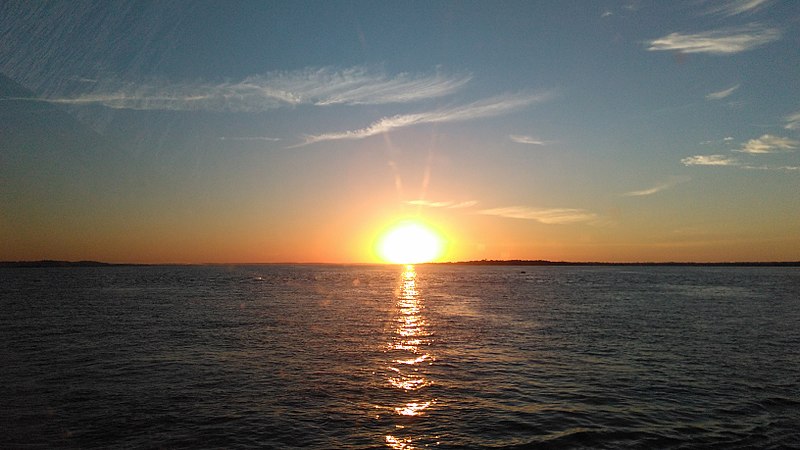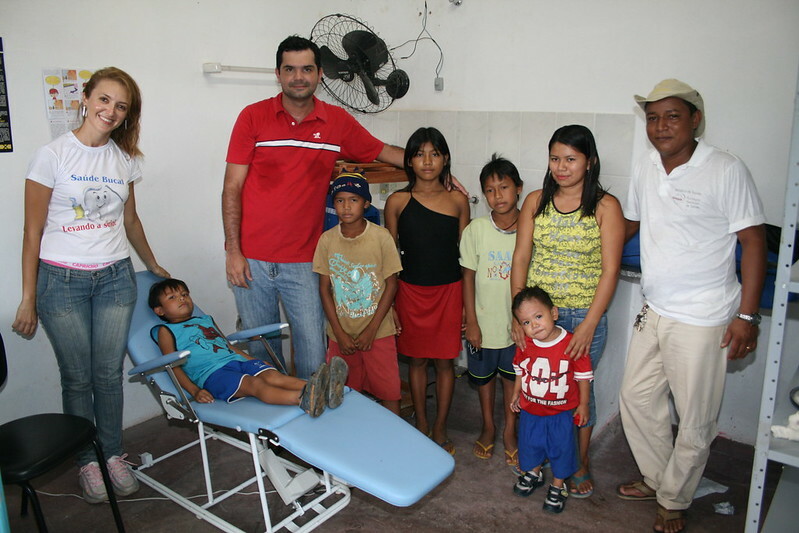
In the speech, Antenor Karitiana.
Photo: Moreira Mariz/Agencia Senado Source: Federal Senate, CC BY 2.0, via Wikimedia Commons
The Karitiana are an Amazonian indigenous people located in the state of Rôndônia, Federative Republic of Brazil. From its cosmovision, the origin myth of the Karitian Sun shows the human transformed into divinity, representing life itself through Gopyk.
Name and population Karitiana
The origin and etymology of the word Karitiana is practically unknown. It is likely that this name was imposed by rubber tappers in the late nineteenth and early twentieth centuries (FUNAI, 1986) (3). The indigenous Karitiana call themselves Yjxa, the inclusive first person plural pronoun “we,” translated as “people” (Cruz, March 22, 2019) (1).
The population of this indigenous people is estimated to be approximately 396 people, who mainly inhabit the Karitiana village (Rocha, cited by Storto, Karitiana and Karitiana, 2019) (5).
Territory
According to Cruz, Azanha and Maretto (2005) (2), the Jamari, Candeias and Jaci-Paraná rivers and their tributaries comprise the ancestral territory of the Karitiana people. In fact, it covers the region located between the Candeias and Jamari rivers; it also includes the lands of the current demarcated area and the valley of the Branco river, a tributary of the Jaci-Paraná. The current territory of the Karitiana is located 95 km from Porto Velho, south of Porto Velho, capital of the state of Rondônia.

Gokyp The Myth of the Sun Karitiana
From the Karitian beliefs , Gokyp would have begun his existence as a human being, as a sick child who had a fever since birth, and was getting hotter and hotter, to the point of frightening the members of this indigenous community, which resulted in the desire to kill him because he was seen as a threat. Over time, this boy grew larger and more incandescent, so some Karitiana men joined together, club in hand, to kill him. In this attempt, they managed to break Gopyk‘s skull, who was badly wounded and went up into the sky, smashing the roof of the house. In the process of fleeing and ascending to heaven, Gopyk singing asks the women of the heavenly plane to let him in because he finds himself with a broken skull (Storto, Karitiana and Karitiana, 2019) (5). Thus, Gopyk shines brightly from on high on the people and life of the Karitiana.
Language
The Karitiana language belongs to the Arikém branch of the Tupi linguistic family. According to some linguistic studies, the Karitian language is the only surviving member of this family. Portuguese is the second language spoken by the Karitiana (Storto, Karitiana and Karitiana, 2019) (5).
Social organization: two peoples with the same roots
Currently, the Karitiana village is divided in the middle by the igarapé Sapoti, a tributary of the Candeias River. This indigenous community is divided into two groups, with each group accounting for approximately half of the village’s population. On the one hand, the “people of the pajé (shaman)” are identified, comprising families that remain faithful to the traditional Karitiana way of life and beliefs, and on the other hand, the “people of the pastor” or believers in the evangelical church. The families of the former reside mainly in the more central part of the right bank of the river. igarapéThe houses form an integrated nucleus around the shaman’s dwelling, while the families led by the “shepherd” are located mostly on the left bank and at the ends of the right bank (Instituto Socioambiental, ISA, n.d.) (4).

Credit: Disclosure / Ministry of Mines and Energy (April 2009) Some rights reserved.
Marriage and patrilocal residence
In general, the Karitiana maintain polygamous marital relationships and traditionally the residence follows the patrilocal rule, i.e. the couple resides in houses close to that of the husband’s parents (Cruz, Azanha and Maretto, 2005) (2).
Economic activities
Historically, the Karitiana have practiced slash-and-burn agriculture, carried out by family units, cultivating mainly cassava, corn, rice, beans, sweet potatoes, yams, bananas, peanuts, coffee, among others. Around the houses, each family maintains “quintales” or patios with a variety of fruit trees. However, it cannot be ruled out that they may place small surpluses in the markets, especially in Porto Velho. The Karitiana also hunt animals and birds, with monkey meat being the most prized; they also engage in fishing and gathering for subsistence purposes, as in other indigenous groups (ISA, n.d.) (4).
In addition, the families of this indigenous Amazonian ethnic group make various handicrafts that are sold at the offices of the Karitiana People’s Association(Akot Pytim’adnipa) or at handicraft fairs in the capital of Rondônia and other cities in the region. (Instituto Socioambiental, ISA, n.d.) (4). The Karitiana use materials provided by the jungle in the elaboration of handicrafts; for example, they use paxiuba, an Amazonian palm, and various feathers and fibers. These Indians produce various types of weapons such as the mace, bow and arrow, which are still used today in hunting and fishing; they also make necklaces and bracelets with animal teeth and seeds of açaí, cumaruna, mulungu and cumare.
Irregular collection and sale of genetic material Karitiana
In 1996 it was reported that ten samples of DNA and Karitiana cell lineages were offered on the Internet by the company Coriell Cell Repositories (CCR), with prices ranging from US$ 85 (for cell culture) to US$ 55 for DNA samples. This news gave rise to an intense debate involving the National Indian Foundation (FUNAI), Congress and indigenous rights organizations, since it is presumed that these samples were taken under false pretenses. Therefore, that year the Karitiana sent a letter to the Attorney General of the Republic in the state of Rondônia, denouncing that the blood samples were taken in the village and in Porto Velho for the purpose of health examinations; so that in the process of the investigations, the Federal Public Prosecutor’s Office opened a Public Civil Action, stipulating compensation in favor of the Indians. Karitiana (ISA, n.d.).
References
- Cruz, M. (March 22, 2019). In an exchange of knowledge, Karitiana Indians reveal that they consume water from trees and vines. Portal of the Government of the State of Rondônia. Secretary of State for Environmental Development (SEDAM). Retrieved from http://www.sedam.ro.gov.br/na-troca-de-saberes-indigenas-karitiana-revelam-que-consomem-agua-de-arvores-e-cipos/.
- Cruz, A., Azanha, G. and Maretto, L. C. 2005. Socioeconomic study on the lands and indigenous peoples located in the area of influence of the Madeira River developments (JIRAU and San Antonio). Retrieved from https://biblioteca.trabalhoindigenista.org.br/wp-content/uploads/sites/5/2018/06/MadeiraDiagnosticoPovosIndigenas.pdf.
- Fundaçao Nacional do Indio. 1986. Report on the Karitiana Indians. Retrieved from https://acervo.socioambiental.org/sites/default/files/documents/KTD00007.pdf.
- Instituto Socioambiental do Brasil, ISA. S.f. Povos indígenas no Brasil. Karitiana. Retrieved from https://pib.socioambiental.org/es/Povo:Karitiana.
- Storto, L., Karitiana, G., and Karitiana, N. 2019. Karitiana. Gokyp. O Sol. Revista Lingüística, 15 (1), 418-445. Retrieved from https://revistas.ufrj.br/index.php/rl/article/view/25577/13854.

Economist (Central University of Venezuela). Full professor and researcher attached to the “Edgar Abreu Olivo” Agrifood Research Center, Universidad de Los Andes. Doctor from the University of La Laguna (Spain). Award “One of the 10 most consulted authors of the Saber ULA university portal” (2005); prize in the III Essay Contest of the Central Bank of Venezuela BCvoz Economico, 2016, with the work “Theobroma cacao: transformation and consumption of the “food of the gods” in Venezuela and the world” (co-authored).
This post is also available in:
![]() Español (Spanish)
Español (Spanish)
